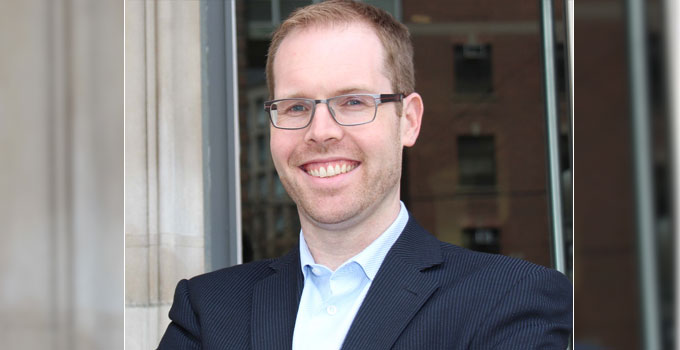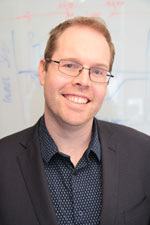
In May, OICR welcomed Dr. Trevor Pugh as Director of Genomics and Senior Principal Investigator. Trevor is a cancer genomics researcher and board-certified molecular geneticist who has led the Princess Margaret Cancer Centre-OICR Translational Genomics Laboratory (PM-OICR TGL) since 2016.
In his new role, he will lead the OICR Genomics program, which brings together the Princess Margaret Genomics Centre, OICR’s Genome Technologies, Translational Genomics Laboratory and Genome Sequence Informatics teams under an integrated initiative to support basic, translational and clinical research. Here, Pugh describes some of his strategies and how he plans to take on this ambitious mandate.
You’re involved with a number of projects across many disease sites and you collaborate with researchers from vastly different areas of cancer research. Can you summarize what you focus on?
Simply put – I want to use genome technologies to guide the best patient care. The overall philosophy is to extract as much genomic information as we can from small amounts of tumour tissue, and turn that information into knowledge so that clinicians and patients can make targeted treatment decisions. I also want to open up these comprehensive data for researchers to mine and find new cures for these cancers.
Whether they are a graduate student working on myeloma or a postdoc working on liver cancer, we all learn from one another’s disease specialties.
And yes – I am involved with many areas of cancer research. Every member in my lab speaks the same genomics language. Whether they are a graduate student working on myeloma or a postdoc working on liver cancer, we all learn from one another’s disease specialties. We do genomics in a similar way as there are many genomic commonalities across cancer types and computational algorithms or infrastructure we build for one project invariably get reused for another project.
You are a board-certified molecular geneticist and a genomics researcher, but you also have a background in bioinformatics and software development. How do you balance making tools and making discoveries?
The tools we create and the research we perform go hand in hand. You can’t make discoveries without the infrastructure, and it is hard to develop technologies successfully without a guiding scientific question. With that said, the software that we make is designed to help not only our own research and clinical projects, but those of others. If we can make software work for us really well, we want to share it and make it easier for groups and labs across Ontario and around the world. This also holds for the data we generate, as there is great value to integrating our data with similar data sets from other hospitals.
How will this new role help you do that?
I have a few main goals in this role that I’m excited about. The first and the largest is to integrate the Princess Margaret Genomics Centre, PM-OICR TGL, Genome Technologies and Genome Sequence Informatics into one fully-coordinated machine. The people, tools and methods that we have at OICR and Princess Margaret are incredible and the infrastructure already in place can serve as a powerful vehicle for both research and clinical applications. In the first two weeks, I’ve been really impressed with how the leads of these programs have come together to form concrete plans for making this a reality.
The part that excites me about my new role is the O in OICR. Within this position, I can have a provincial outlook on translational research which is important as genomics research becomes increasingly dependent on multi-centre studies and inter-institutional collaborations. I think OICR can help facilitate a future where sharing ideas, data, and knowledge between institutions is much easier than it is today. I’m excited to help take things that work locally and make them available and easy-to-use across the entire province, so that we can benefit from the advances made by our neighbours. We are stronger when we work together in a collaborative way.
OICR is well-known as a developer of similar high-quality data sharing systems and I am looking forward to integrating these efforts to support our internal genomics enterprise

It sounds like a lot of your work addresses local needs, but how do you have so many international collaborations?
In computational biology, a lot of our concerns and challenges are shared with other groups as well. For example, the cBioPortal data sharing platform was originally built at Memorial-Sloan Kettering to allow researchers to easily query data from The Cancer Genome Atlas project. This initiative soon grew to include a team at Dana-Faber and now the software is fully open-source with five core, NIH-funded teams contributing to its development, including my own lab. In addition, there are groups working on improving and enhancing cBioPortal instances around the world as it expands to new applications beyond genomics. cBioPortal has emerged as a very powerful resource rooted in an international crowdsourcing model. Naturally, OICR is well-known as a developer of similar high-quality data sharing systems and I am looking forward to integrating these efforts to support our internal genomics enterprise, as well as national and international data sharing networks.
You’ve been involved with the evolution of genomics over the last two decades. What technologies excite you these days?
Hands down, it’s single cell sequencing. This is an amazing technology that allows us to see parts of the tumours that we could never see before. In one of my projects, we’re looking at each cancer population within a tumour sample and mapping each population to a drug treatment. With Drs. Benjamin Haibe-Kains, we’re applying this concept across hundreds of thousands of cells from brain tumours we have sequenced in collaboration with Peter Dirks and from myeloma cells with Suzanne Trudel. If we can find distinct clones – or types of cells – with tailored treatment options, we could potentially eradicate the cancer entirely using combination therapies. I think the future of precision medicine is dependent on single cell technology and I look forward to integrating this technology into clinical studies with collaborators at cancer centres across the province.
